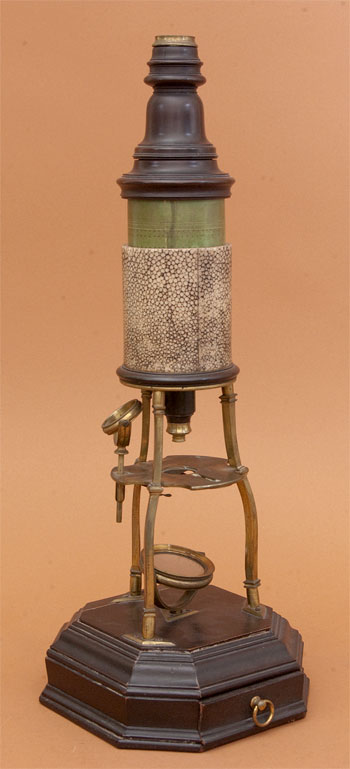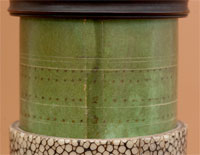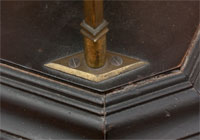 |
|||||
 |
 |
||||
 |
|||||
 |
 |
||||
Matthew Loft Tripod Compound Microscope (No. 89) |
|||||||
 |
Age: 1725-1745 Made by: Possibly Matthew Loft Made in: London |
||||||
 |
|||||||
|
Gold-tooled focus markings
|
|||||||
 |
|||||||
|
Triangular support base
|
|||||||
|
This is an unsigned Culpeper-style tripod microscope possibly made by Matthew Loft (1697–1747) of London. Loft was an apprentice of Thomas Gay from Aug 15, 1711 through Jan. 12, 1720. Immediately after which he started his own scientific instrument shop at the Golden Spectacles on Threadneedle Street, located on the Backside of the Royal Exchange. Loft made instruments such as the microscope shown here as well as telescopes, drawing instruments (e.g., Hadley's Quadrant), and slide rules. Instruments of this style were popular in London during the 1730s and 40s. Of particular interest is that Loft made a brass tripod microscope for Dr. Demainbray, tutor to George III. This microscope in the Golub Collection has the style of the first type of tripod microscope by Loft. It has three bowed legs screwed to diamond- shaped plates on an octagonal dyed oak base. The legs are diamond-shaped in cross-section, as compared to the round legs of Scarlett and Culpeper. The stage is triangular in shape and has a keyhole shaped slot for accessories such as a fish plate. Samples are fixed to the stage using a Bonanni spring stage, a holder for glass phials, and two curved spring clips underneath the stage also for glass phials. The microscope body consists of a cardboard draw tube covered in green vellum with gold-tooled lines and focus position numbers. At the top of the tube is a wooden collar that supports the field lens, and distal to that is a turned wooden eyelens tube. Capping this piece is a brass sliding dust cover. Below the draw tube is the objective snout made from turned wood. The wood of all three pieces is Lignum vitae. During focusing the microscope body slides within an outer cardboard tube covered in mottled black and white shagreen (dyed ray skin). This instrument comes with five objective lenses numbered 0–4; each with a single bi-convex lens. The microscope has two sample illumination lenses: a bull's eye lens mounted to the sample stage and a substage mirror. The gimbal for the mirror is set in a diamond-shaped plate in the center of the base. Accessories are two bone sample slides and a forceps/pointer. The entire microscope is 45cm tall. Signed Loft microscopes identical to this one are described in Clay & Court. Unsigned microscopes like this are also described by Turner, the Museum Boerhaave, and the Billings Collection. |
|||||||
Microscope featured 02/2012